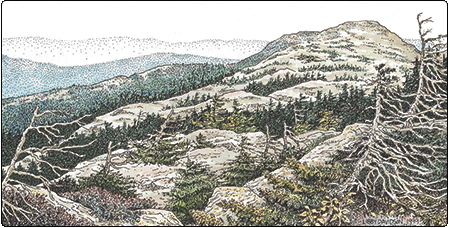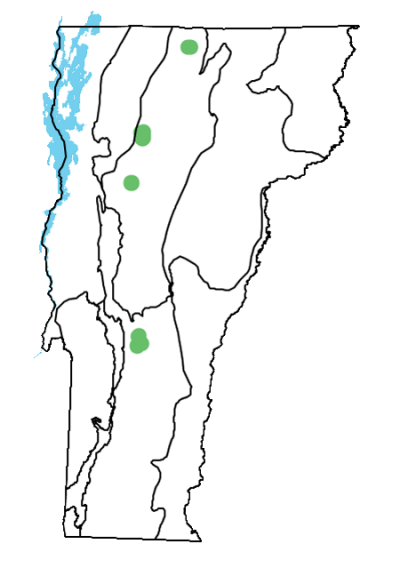Ecology and Physical Setting
“Krummholz” is a German word meaning “crooked wood.” At the highest elevations where trees can be found, above 3,500 feet in Vermont’s mountains, harsh winds, ice, and snow put such stresses on trees that they never grow to full size. Precipitation at this elevation is high: over 70 inches per year as compared with less than 35 inches per year in the Champlain Valley. Average annual temperatures are low. Fog is commonplace in summer. Soils are mostly thin, undecomposed organic layers over bedrock and are near saturation most of the year.
Vegetation
Subalpine Krummholz is transitional between Montane Spruce-Fir Forest below and Alpine Meadow above, so it shares species with both. Balsam fir and black spruce, the two dominants in Subalpine Krummholz, grow low to the ground, bending and twisting in response to wind, snow loading, and ice. Growth rates are very slow under these conditions. The woody plants range in height from a few inches to a few feet and often grow so densely, and have such stiff branches, that they form an impenetrable thicket. Getting through such a thicket might require crawling on one’s belly or scrambling over the tops of the matted trees.
Occasional showy mountain ash and heart-leaved paper birch are mixed in with the softwoods. Several of the common boreal forest herbs (Canada mayflower, bunchberry, brownish sedge, hoary sedge, and bluebead lily, among others) grow beneath the stunted trees. Velvetleaf blueberry and other heath shrubs are scattered under or among the stunted spruce and fir. Mosses and lichens are abundant.
Wildlife Habitat
The harsh climate and exposed conditions of Subalpine Krummholz provide important habitat for several small but hardy animals. Bicknell’s thrush is one of North America’s rarest songbirds, breeding only in the mountains of New York, New England, Québec, and the Maritime Provinces. Its distinctive and beautiful calls are emblematic of Vermont’s mountaintops and are a reminder of the vulnerability of these balsam fir and spruce forests as the climate warms. Blackpoll warbler is another species of Vermont’s mountaintops, with most of its breeding habitat in the taiga of northern Canada. Dark-eyed juncos nest in sheltered spots on the ground, and white-throated sparrows and yellow-rumped warblers nest in branches of stunted balsam fir. The rare long-tailed shrew and rock vole use rock crevices and areas of talus for cover.
Successional Trends
When individual balsam fir or black spruce die in Subalpine Krummholz, either naturally or due to human influences, they are usually replaced by young seedlings of fir or spruce. In cases where large areas are laid bare and organic matter is scraped off the soil surface, hardwoods such as heart-leaved paper birch and mountain maple may become dominant for a time, perhaps persisting for several decades. Many high-elevation stands of heart-leaved paper birch are thought to have originated from fires that followed logging in the early 20th century.
Related Communities
- Alpine Meadow is found above treeline, and therefore usually above Subalpine Krummholz, although the two communities interfinger. Alpine Meadow is generally open, with abundant bare rock, but has patches of low trees in sheltered areas. The two communities share many species in common. The more protected areas of Alpine Meadow are much like Subalpine Krummholz.
- Montane Spruce-Fir Forest is found below Subalpine Krummholz on our mountains, and grades into it. Trees are taller and straighter, and alpine species like alpine bilberry are absent. Soils are deeper and have more mineral content. As one goes down in elevation, black spruce disappears quickly and is replaced by red spruce.
- Red Spruce-Heath Rocky Ridge is typically found below 3,500 feet in elevation, and black spruce is typically absent. Red Spruce-Heath Rocky Ridges can have stunted trees but they lack the dense, matted horizontal growth that characterizes the “crooked wood” of Subalpine Krummholz.
Conservation Status and Management Considerations
Subalpine krummholz is a very rare natural community in Vermont. Several examples are protected, but others are impacted by the development of communication towers and ski area infrastructure.
Distribution/Abundance
Subalpine Krummholz is found only on the highest peaks in the Green Mountains, with well-developed examples on Jay Peak, Mount Mansfield, Camel’s Hump, and Killington. The total land area covered by this community is quite small in Vermont. Subalpine Krummholz is found throughout the northeastern United States, mostly above 3,500 feet, and well into Canada, with the upper elevational limit decreasing as one moves north.
Characteristic Plants
Trees
Abundant Species
Balsam fir – Abies balsamea
Black spruce – Picea mariana
Occasional to Locally Abundant Species
Red spruce – Picea rubens
American mountain ash – Sorbus americana
Showy mountain ash – Sorbus decora
Heart-leaved paper birch – Betula cordifolia
Shrubs

portions of Subalpine Krummholz.
Occasional to Locally Abundant Species
Northern blueberry – Vaccinium boreale
Velvetleaf blueberry – Vaccinium myrtilloides
Alpine bilberry – Vaccinium uliginosum
Labrador tea – Rhododendron groenlandicum
Bartram’s shadbush – Amelanchier bartramiana
Mountain maple – Acer spicatum
Mountain cranberry – Vaccinium vitis-idaea
Herbs
Occasional to Locally Abundant Species
Canada mayflower – Maianthemum canadense
Bunchberry – Cornus canadensis
Brownish sedge – Carex brunnescens
Hoary sedge – Carex canescens
Bluebead lily – Clintonia borealis
Common wood sorrel – Oxalis montana
Goldthread – Coptis trifolia
Three-toothed cinquefoil – Sibbaldia tridentata
Appalachian firmoss – Huperzia appressa
Rare and Uncommon Plants
Lesser pyrola – Pyrola minor
Squashberry – Viburnum edule
Alpine bilberry – Vaccinium uliginosum
Showy mountain ash – Sorbus decora
Northern blueberry – Vaccinium boreale
Mountain cranberry – Vaccinium vitis-idaea
Dwarf birch - Betula minor
Associated Animals
Snowshoe hare – Lepus americanus
Dark-eyed junco – Junco hyemalis
White-throated sparrow – Zonotrichia albicollis
Blackpoll warbler – Setophaga striata
Yellow-rumped warbler – Setophaga coronata
Rare and Uncommon Animals
Long-tailed shrew – Sorex dispar
Rock vole – Microtus chrotorrhinus
Bicknell’s thrush – Catharus bicknelli
Places to Visit
Mount Mansfield, Cambridge and Underhill, Mount Mansfield State Forest, Vermont Department of Forests, Parks, and Recreation (VDFPR)
Killington Peak, Coolidge State Forest, VDFPR
Camel’s Hump, Huntington and Duxbury, Camel’s Hump State Park, VDFPR
